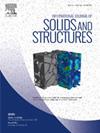塑性金属弹塑性与损伤的微观力学模拟
IF 3.8
3区 工程技术
Q1 MECHANICS
International Journal of Solids and Structures
Pub Date : 2025-05-08
DOI:10.1016/j.ijsolstr.2025.113437
引用次数: 0
摘要
尽管塑性金属宏观力学行为的计算本构模型已经得到了广泛的研究,但塑性金属力学行为的复杂性仍然对现有模型提出了挑战。理想情况下,该模型必须准确预测材料在比例和非比例载荷下的弹塑性行为,单轴和多轴应力状态下的断裂行为以及循环载荷下的行为。此外,该模型必须与从同一金属合金制成的样品中获得的各种测试数据进行测试。在这项研究中,我们提出了一个使用微平面方法的本构模型,其中应力应变关系根据应力和应变向量在各个平面上定义,并根据应变张量独立激活,有效地创建了多面塑性模型。本构关系由两个单独的应力-应变边界组成:一个用于剪切行为,另一个用于偏差行为。数据拟合经验表明,应力三轴性只能在偏边界处考虑。两个边界都包含了损伤演化。根据6061-T6、2024-T4和7075-T651铝合金试样的实验数据对模型进行了校准,并将模型预测结果与同一合金试样的实验数据进行了比较。此外,将模型预测与另一种称为MPJ2模型的微平面模型进行比较。除了各应力三轴的试验数据外,还考虑了顶点效应和包辛格效应的试验数据。本文章由计算机程序翻译,如有差异,请以英文原文为准。

Micromechanical modelling of the elastoplasticity and damage in ductile metals
Even though the computational constitutive modelling of the mechanical behavior of ductile metals at macroscopic scale has been studied extensively, the complexities in the mechanical behavior of ductile metals continue to challenge the existing models. Ideally the model must predict accurately the elastoplastic behavior of the material under both proportional and non-proportional loadings, its fracturing behavior under both uniaxial and multiaxial stress states as well as its behavior under cyclic loadings. Furthermore, the model must be tested against various test data obtained from specimens made of the same metal alloy. In this study, we present a constitutive model using the microplane approach in which the stress–strain relations are defined on various planes in terms of stress and strain vectors, which are independently activated depending on the strain tensor, effectively creating a multisurface plasticity model. The constitutive relations consist of two separate stress–strain boundaries applied on any given microplane: One for the shear behavior and another for the deviatoric behavior. Data fitting experience revealed that stress triaxiality must be considered only in the deviatoric boundary. Damage evolution is incorporated into both boundaries. The model is calibrated against experimental data obtained from specimens made of Aluminum alloys (6061-T6, 2024-T4 and 7075-T651) and the model predictions are compared against experimental data obtained from specimens made of the same alloy. Furthermore, the model predictions are compared to a different microplane model called the model MPJ2. In addition to test data at various stress triaxialities, test data on Vertex effect and Bauschinger effect are also taken into account.
求助全文
通过发布文献求助,成功后即可免费获取论文全文。
去求助
来源期刊
CiteScore
6.70
自引率
8.30%
发文量
405
审稿时长
70 days
期刊介绍:
The International Journal of Solids and Structures has as its objective the publication and dissemination of original research in Mechanics of Solids and Structures as a field of Applied Science and Engineering. It fosters thus the exchange of ideas among workers in different parts of the world and also among workers who emphasize different aspects of the foundations and applications of the field.
Standing as it does at the cross-roads of Materials Science, Life Sciences, Mathematics, Physics and Engineering Design, the Mechanics of Solids and Structures is experiencing considerable growth as a result of recent technological advances. The Journal, by providing an international medium of communication, is encouraging this growth and is encompassing all aspects of the field from the more classical problems of structural analysis to mechanics of solids continually interacting with other media and including fracture, flow, wave propagation, heat transfer, thermal effects in solids, optimum design methods, model analysis, structural topology and numerical techniques. Interest extends to both inorganic and organic solids and structures.

 求助内容:
求助内容: 应助结果提醒方式:
应助结果提醒方式:


